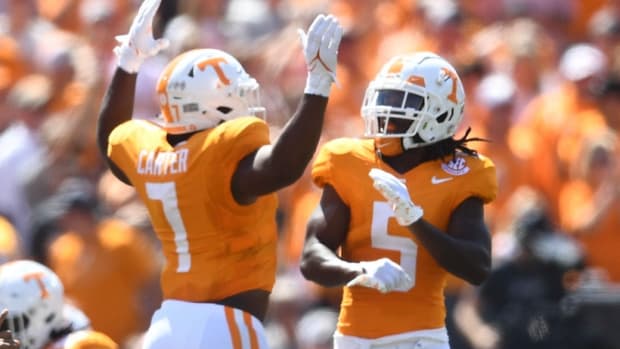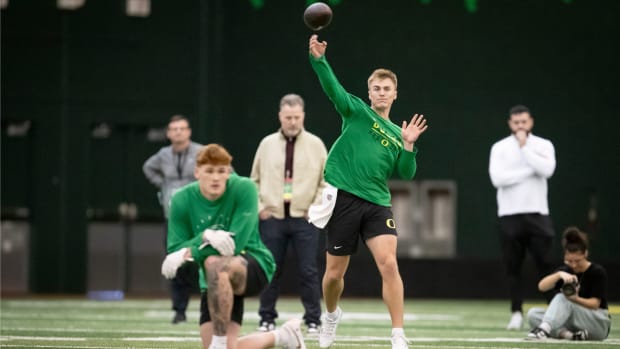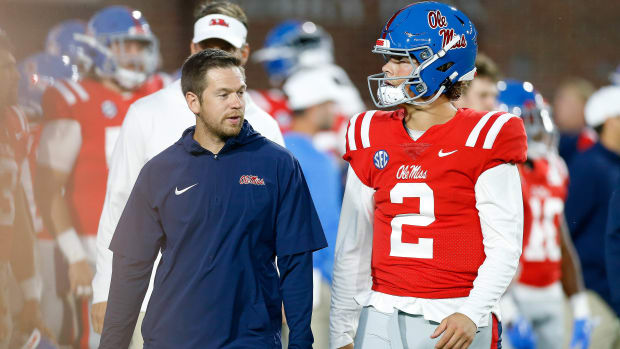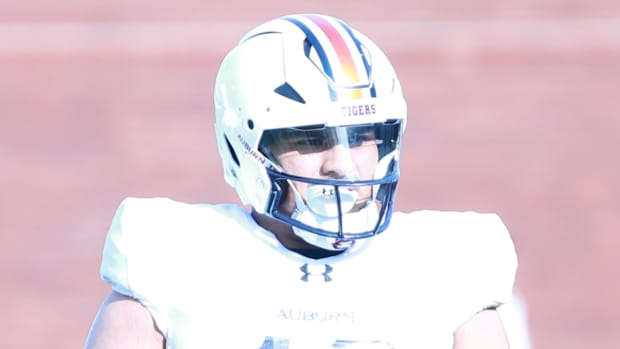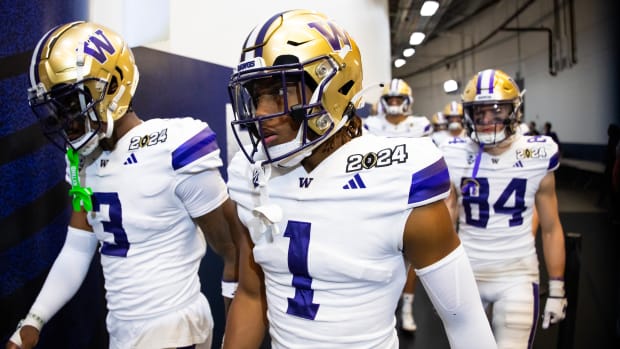Post-Spring Top 25: Resetting the Pecking Order at the Offseason's Midpoint
We’re still just under four months away from Week 1, but enough has changed in the four months since the night of Alabama’s title-game victory over Georgia to reassess college football’s national landscape. Many of last season’s stars are now in the NFL, while others returned to school to use up remaining eligibility. A large portion of incoming recruits won’t be on campus until the summer, but some of the most anticipated arrivals enrolled in time to participate in spring drills and performed well enough to suggest they’ll become household names this fall. Injuries and transfers resulted in roster upgrades and downgrades, with more sure to come before early September.
All of those developments have been incorporated into this post-spring Top 25, which will be updated again before the start of the season.
1. Alabama
The Crimson Tide just set an SEC record by having 12 players selected in the draft, including four in the first round. An exodus on that scale would set back most programs for a season, if not longer, but Alabama showed this spring that it’s ready to defend its fifth title in nine years. Linebackers Mack Wilson (junior) and Dylan Moses (sophomore) and linemen Isaiah Buggs (senior) and Raekwon Davis (junior) will lead a frightening front seven, and the winner of the ongoing quarterback battle between junior Jalen Hurts and sophomore Tua Tagovailoa (who missed most of the spring with an injury his throwing hand suffered during the first workout) will have the option of complementing a powerful, multi-pronged running attack with a promising receiving corps that can stretch defenses.
2. Clemson
The biggest question hanging over Clemson this spring was whether senior Kelly Bryant would manage to hold off a group of underclassmen—including early enrollee true freshman Trevor Lawrence, the No. 1 recruit in the class of 2018 according to the 247Sports Composite—for the starting quarterback job. The reality is that it probably doesn’t matter all that much.
The Tigers brought back a handful of key pieces from a dominant defense, including senior tackle Christian Wilkins and fifth-year senior linebacker Kendall Joseph. Sophomore Tee Higgins showed glimpses this spring of the big-play ability that made him such a highly regarded prospect coming out of Oak Ridge (Tenn.) High and could soften the blow of losing wideouts Deon Cain and Ray-Ray McCloud to the NFL.
3. Ohio State
The Buckeyes offered evidence this spring of why they belong in the playoff conversation every offseason, regardless of how many players they lose to graduation or the NFL, as long as head coach Urban Meyer is in charge. The position group hardest hit by draft-related departures this year—defensive line, with ends Tyquan Lewis, Sam Hubbard and Jalyn Holmes all hearing their names called by early in the fourth round—could end up being Ohio State’s chief strength in 2018.
Sophomore Chase Young hinted at his high ceiling during the Buckeyes’ spring game, and he’ll be joined up front by other disruptive forces like redshirt junior Dre’Mont Jones and juniors Jonathon Cooper and Nick Bosa.
4. Washington
Running back Myles Gaskin’s choice to come back to Seattle for his senior season could end up being one of the most consequential NFL draft decisions of the year, but that was far from the only positive development for the Huskies this spring. Junior wide receiver Aaron Fuller built his case to become senior quarterback Jake Browning’s go-to target following the departure of Dante Pettis, and sophomores Keith Taylor and Elijah Molden asserted themselves in a secondary returning standout junior Taylor Rapp and breakout candidate Byron Murphy, a redshirt sophomore who was limited to only six games last season because of a broken foot.
5. Wisconsin
The Badgers were the class of the Big Ten West last season, and that should be the case again in 2018. All five starters on the offensive line return to protect redshirt junior quarterback Alex Hornibrook. Sophomore tailback Jonathan Taylor gives the Badgers an every-down workhorse with breakaway speed, and junior Quintez Cephus—who was limited this spring after a right leg injury cut short his sophomore season—has all-conference potential. Isaiahh Loudermilk, a 6'7", 297-pound redshirt sophomore, can mitigate the impact of the Badgers losing senior ends Conor Sheehy, Chikwe Obasih and Alec James. Junior Garrett Rand’s move from nose guard to the outside will also help that cause.
6. Miami
The Hurricanes are retooling along the defensive line after watching Chad Thomas, R.J. McIntosh and Kendrick Norton get drafted, DJ Johnson transfer to Oregon and respected DL coach Craig Kuligowski leave for Alabama. That said, stud linebacker Shaquille Quarterman (junior) is back to anchor the middle of the defense, and play-making safety Jaquan Johnson (senior) returns to patrol the back end. Miami was set at running back before signing day, with both junior Travis Homer and sophomore DeeJay Dallas returning, but when in need of a big play, the Hurricanes should be able to turn to early enrollee true freshman Lorenzo Lingard. The six-foot, 195-pound five-star prospect out of Orange City, Fla., competed with the Hurricanes’ track team this spring.
7. Oklahoma
If redshirt junior Kyler Murray decides to play football for the Sooners this fall rather than to begin his professional baseball career—ESPN’s Keith Law listed him last month as the No. 36 overall prospect for Major League Baseball’s June 4 draft—he has an electric, dual-threat skill set that would enable him to excel in second-year head coach Lincoln Riley’s high-octane offense. Whatever Murray decides, redshirt sophomore Austin Kendall did enough this spring to keep alive the battle to replace No. 1 pick and Heisman Trophy winner Baker Mayfield. Versatile defensive back Brendan ‘Bookie’ Radley-Hiles, a top-40 recruit in the class of 2018 out of IMG (Fla.) Academy, according to the 247Sports Composite, also drew positive reviews.
8. Georgia
Near the top of the Bulldogs’ agenda this spring: Settling on the players who could fill in for the four starting linebackers who departed in the offseason, among them Butkus Award recipient and No. 8 draft pick Roquan Smith. In Georgia’s G-Day game, sophomore Monty Rice distinguished himself as a prime candidate to start inside with 14 tackles, a tackle for loss and a sack. Top-flight quarterback recruit Justin Fields flashed his upside as a run/pass dynamo, but it could be difficult for him to usurp sophomore Jake Fromm as the Bulldogs’ starter. Georgia has a deep group of pass catchers—including junior tight end Isaac Nauta, senior wideout Terry Godwin and junior wideouts Mecole Hardman and Riley Ridley, who recorded a team-high 82 yards on six catches in the national title game—to offset the loss of leading receiver Javon Wims.
9. TCU
Sophomore quarterback Shawn Robinson, who played in six games in relief of Kenny Hill last season, is the Horned Frogs’ presumptive Week 1 starter coming out of the spring. He’ll need to contend with a shaky offensive line that’s breaking in four new starters, but Robinson will have no shortage of playmakers on the outside to work with.Early enrollee true freshman Taye Barber, a three-star prospect whom head coach Gary Patterson lauded during the spring, provides another threat alongside senior KaVontae Turpin and sophomore leap candidate Jalen Reagor. (You might remember Reagor from TCU’s thrilling comeback win over Stanford in the Alamo Bowl, in which he registered a team-high 169 receiving yards and a touchdown on five catches.)
10. Michigan State
The Spartans didn’t lose much of note from the team that won 10 games last season; 19 of 22 starters are back. Junior quarterback Brian Lewerke, a 15-game starter who can burn defenses with his arm (2,793 yards, 20 touchdowns, seven interceptions in 2017) and his legs (559 yards and five TDs), will team with senior tailback LJ Scott to form one of the most formidable backfield tandems in the Big Ten. The defense should remain stout despite co-defensive coordinator Harlon Barnett’s decision to join new Florida State head coach Willie Taggart’s staff. Four-star true freshman safety Xavier Henderson and four-star true freshman cornerback Kalon Gervin made positive impressions this spring.
11. Stanford
Heisman Trophy finalist Bryce Love didn’t participate in contact drills this spring as he continues to rehabilitate an ankle sprain that dogged him toward the end of his resplendent junior season, but his choice to return to Palo Alto rather than jump to the pros could tilt the Pac-12 North in the Cardinal’s favor. While Keller Chryst’s graduate transfer to Tennessee and injuries to redshirt freshman Davis Mills and junior starter K.J. Costello left walk-on Jack Richardson—who has since been rewarded with a scholarship—as Stanford’s only healthy quarterback this spring, that didn’t prevent sophomore wide receiver Connor Wedington from turning heads in the Cardinal and White Game last month with six catches for 68 yards and a touchdown.
12. West Virginia
The Mountaineers should have no trouble keeping up with the scoreboard-rattling offenses around the Big 12 this season. Fifth-year senior quarterback Will Grier will light up opposing defenses through the air by connecting with 2017 national receiving touchdown co-leader David Sills V and leading receiver Gary Jennings, both of whom are seniors. Redshirt junior David Long Jr., who was sidelined this spring while rehabilitating from shoulder surgery, is a top-line talent at linebacker, and USC graduate transfer Kenny Bigelow, who was granted a sixth year of eligibility after temporarily transitioning to a coaching role with the Trojans last season, can help the Mountaineers cope with the transfer of freshman standout Lamonte McDougle.
13. Michigan
Last month’s joint announcement from Ole Miss and Michigan that highly regarded Rebels transfer quarterback Shea Patterson would be eligible this season offered renewed hope for an offense that ranked eighth in the Big Ten in points per game last season and produced only seven points in the Wolverines’ Outback Bowl loss to South Carolina. So, too, will a revamped coaching staff on that side of the ball, including former Florida head coach Jim McElwain (now coaching wide receivers) and former Ohio State offensive coordinator Ed Warriner (offensive line coach). Third-year defensive coordinator Don Brown should again oversee one of the Power 5’s nastiest defenses, headed by playmakers like junior linebackers Khaleke Hudson and Devin Bush, junior defensive lineman Rashan Gary and fifth-year senior lineman Chase Winovich.
14. UCF
Scott Frost’s jump at the end of last season to become Nebraska’s head coach won’t derail the self-proclaimed reigning national champions. Another bid to a New Year’s Six Bowl feels within reach. Frost’s replacement, Josh Heupel, directed Missouri’s SEC-leading offense in 2017. He inherits a proven stable of running backs led by junior Adrian Killins Jr. and a potent triggerman under center in junior McKenzie Milton, who last season threw for 4,037 yards and ranked behind only Oklahoma’s Baker Mayfield in passing efficiency. Leading tackler Pat Jasinski is back for his senior campaign, but filling the voids left by first-round draft pick Mike Hughes in the secondary and fifth-round pick Shaquem Griffin at linebacker is a tall order.
15. USC
One player who could go a long way toward determining USC’s success this season, incoming quarterback recruit J.T. Daniels, wasn’t around this spring. This fall, the 247Sports Composite’s No. 2 signal-caller, who effectively skipped a year at Mater Dei (Calif.) High as part of a reclassification from 2019 to ’18, will join redshirt freshman Jack Sears and third-year sophomore Matt Fink in the competition to succeed No. 3 draft pick Sam Darnold.
Also missing from spring workouts was a player the Trojans will lean on to fill in for running back Ronald Jones, their second-highest draft pick behind Darnold: Sophomore Stephen Carr was recovering from back surgery. Senior cornerback Iman Marshall drew praise for his work this spring.
16. Auburn
Offseason surgery to redshirt junior quarterback Jarrett Stidham’s non-throwing shoulder was hardly the most serious injury-related news on the Plains this offseason. The Heisman Trophy candidate, who was limited while recovering from the procedure this spring, saw two important members of his wide receiver corps go down with torn ACLs: junior Eli Stove and senior Will Hastings. Former Baylor transfer Kam Martin cemented himself as the Tigers’ No. 1 running back following the departure of SEC offensive player of the year Kerryon Johnson, and defensive end Nick Coe followed up his all-freshman SEC nomination from last season by earning defensive MVP honors in Auburn’s A-Day game.
17. Mississippi State
Senior quarterback Nick Fitzgerald continues to work back from the gruesome ankle injury he suffered in last season’s Egg Bowl loss to Ole Miss, and he’s expected to be fully healthy come fall camp. Barring any setbacks in his recovery, Fitzgerald has the mobility and the passing chops to blossom in new coach Joe Moorhead’s pace-pushing offense. A new potential target for Fitzgerald rose to the occasion this spring in redshirt freshman wideout Austin Williams. Junior linebacker Leo Lewis’s arrest on a disorderly conduct charge last week marked a negative note in an offseason defined by the excitement stemming from the widely praised hiring process that landed Moorhead, the former Penn State offensive coordinator.
18. Penn State
The program Moorhead left behind should be in decent shape even without All-America running back and No. 2 pick Saquon Barkley. Promoted offensive coordinator Ricky Rahne can take comfort in dangerous dual-threat quarterback Trace McSorley’s experience as well as the presence of a promising fill-in for Barkley in junior Miles Sanders (375 rushing yards, 6.7 yards per carry in his first two seasons). Freshman linebacker Micah Parsons, the 247Sports Composite’s No. 5 overall player in the class of 2018, could be ready to wreck Big Ten offensive gameplans from the jump. He notched a game-high eight tackles and a sack in the spring game last month. Sophomore Lamont Wade acquitted himself well after switching from cornerback to safety.
19. Virginia Tech
Co-defensive coordinator Galen Scott’s abrupt resignation late last month after the revelation of his alleged involvement in an extramarital affair clouded whatever progress Virginia Tech made on the field this spring. Fortunately for the Hokies, esteemed DC/associate head coach Bud Foster is around to guide Virginia Tech as it rebuilds its linebacker corps, which loses first-round draft pick Tremaine Edmunds and second-leading tackler Andrew Motuapuaka, and its secondary, which loses first-rounder Terrell Edmunds at safety and starting cornerbacks Greg Stroman and Brandon Facyson. Redshirt sophomore quarterback Josh Jackson will have to make do without No. 1 wideout Cam Phillips, who went undrafted. Leading rusher Travon McMillian is also gone.
20. Notre Dame
The Fighting Irish need to address major questions on an offense that saw four starters get drafted this offseason, including a pair of offensive linemen in the top 10 (guard Quenton Nelson and tackle Mike McGlinchey). What’s more, No. 1 running back Josh Adams declared for the draft but didn’t get picked, and two other tailbacks (C.J. Holmes, Deon McIntosh) and a wide receiver (Kevin Stepherson) were dismissed from the team in January. Junior wide receiver Chase Claypool (151 receiving yards, two touchdowns), senior wide receiver Miles Boykin (132 receiving yards, one touchdown) and senior running back Dexter Williams (117 rushing yards, one touchdown) produced in Notre Dame’s Blue-Gold Game, and senior quarterback Brandon Wimbush (19 of 33, 341 yards, two touchdowns, one interception) displayed signs of improvement as a passer.
21. Oregon
Projected future first-round draft pick Justin Herbert stands a good chance of establishing himself as the Pac-12’s top quarterback now that USC’s Sam Darnold and UCLA’s Josh Rosen are off to the NFL. (That is, unless Arizona’s Khalil Tate or Washington’s Jake Browning intervene.) Herbert should be well-protected by a seasoned offensive line, and he’ll be able to turn to a running game strengthened by redshirt freshman tailback C.J. Verdell, who bolstered his claim this spring to become a viable alternative to the Ducks’ top returning rusher, redshirt senior Tony Brooks-James. Redshirt freshman wide receiver Daewood Davis flashed in Oregon’s spring game with a team high 75 receiving yards and two touchdowns on three catches.
22. Boise State
The Broncos’ consistency under fifth-year head coach Bryan Harsin suggests the loss of first-round draft pick Leighton Vander Esch at linebacker won’t devastate their defense. Sophomore Riley Whimpey is one candidate to step up in his absence, although it’s unlikely defensive coordinator Andy Avalos will find any player capable of filling the massive statistical hole Vander Esch leaves after amassing 141 total tackles, 8.5 tackles for loss, four sacks and three interceptions in 2017.
The loss of record-setting wide receiver Cedrick Wilson may not be as difficult to overcome. Sophomore Octavius Evans looked like the class of the 2018 receiving corps in the spring game, hauling in five catches for 124 yards with a pair of touchdowns.
23. Texas
A name that most college football observers are going to become familiar with this season if they haven’t already: Lil’Jordan Humphrey. The junior wideout racked up 114 total yards in the Longhorns’ Orange-White spring game, and he could be a real difference-maker in Texas’s passing attack alongside fellow junior Collin Johnson. The quarterback situation in Austin bears similarities to what the Longhorns were dealing with at this time a year ago, as neither junior Shane Buechele nor sophomore Sam Ehlinger seized the starting job during the spring. Second-year head coach Tom Herman may just wind up rotating between the two as he sees fit during the season. Ehlinger started six games and Buechele started seven in 2017.
24. Florida Atlantic
Year two under Lane Kiffin brings the distinct possibility of another 11 wins and Conference USA title under Lane Kiffin. Tailback Devin (Motor) Singletary battled a hamstring injury this spring, but he’ll be back for a junior encore to follow a sterling sophomore campaign in which he led the Football Bowl Subdivision with 32 rushing touchdowns. Junior tackling machine Azeez Al-Shaair (147, third in the FBS) and senior ballhawk Jalen Young (seven INTs) return on defense. The Owls exited the spring without resolving the quarterback battle between Oklahoma transfer Chris Robison and Florida State transfer De’Andre Johnson. It won’t take long to figure out whether Florida Atlantic is for real: It opens at Oklahoma on Sept. 1 and travels to UCF three weeks later.
25. Florida State
Absent an unexpected star turn from one of the quarterbacks competing for the starting job (redshirt junior Deondre Francois, sophomore James Blackman and redshirt freshman Bailey Hockman), sophomore tailback Cam Akers will be the headliner in new head coach Willie Taggart’s Gulf Coast offense, but redshirt freshman Khalan Laborn stole the show in the Seminoles’ Garnet and Gold game on April 14, tallying a game-high 140 yards and two touchdowns on 13 carries, including a 91-yard TD dash. True freshman DB Jaiden Woodbey made a name for himself this spring after showing up on campus as Florida State’s highest-ranked defensive recruit."

